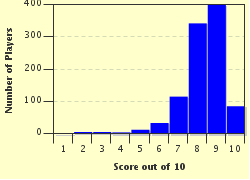Quiz Answer Key and Fun Facts
1. We'll start our tour in this ocean which is the top of the heap - at least, if you look at the globe in its accepted orientation. What is the name of the ocean that surrounds the vicinity of the North Pole?
2. We try harder - the old Avis advertising slogan could be applied to the second-largest of the world's oceans, which separates Europe and Africa from North and South America. What is the name of the ocean we are visiting now?
3. Ahoy, me hearties, we have arrived at a sea which lies to the southeast of the Gulf of Mexico, and was named for one of the indigenous tribes of the area. Which of these seas, known both as a vacation spot and as a pirate haven, are we visiting now?
4. Our next stop takes us well south. Which of these is NOT a name commonly used to describe the ocean that surrounds the continent of Antarctica?
5. The name of the next ocean on our trip would not lead one to expect that it is surrounded by the Ring of Fire, a region of intense tectonic activity leading to numerous volcanoes and frequent earthquakes. Which ocean is surrounded by the infamous Ring of Fire?
6. The Bering Sea is connected to the Arctic Ocean by the Bering Strait. Which country might we be visiting if we are looking out over the Bering Sea?
7. This sea off the east coast of China is the subject of territorial disputes between the People's Republic of China, Japan and South Korea, all of which border it (although Korea is not shown in this map - it lies just to the north of the region shown). Which contentious sea are we cruising through now?
8. The next leg of our trip takes us to the Tasman Sea, lying between Australia and New Zealand, which was named after Abel Tasman, the first European to record visiting New Zealand and Tasmania (guess who they named that island after). What was his nationality?
9. Some of the world's best-known islands are located in an ocean that extends from Africa to Australia, and lies south of mainland Asia. In what ocean will our cruise ship allow us to visit Madagascar and Sri Lanka, among other islands?
10. Moses parted its waters, according to tradition; the Suez Canal connected it to the Mediterranean Sea in 1869; the Sinai Peninsula lies at its northern end. What is the name of the last sea we will visit on our world tour, a sea that ancient geographers sometimes also referred to as the Arabian Gulf or the Sea of Mecca?
Source: Author
looney_tunes
This quiz was reviewed by FunTrivia editor
Pagiedamon before going online.
Any errors found in FunTrivia content are routinely corrected through our feedback system.


